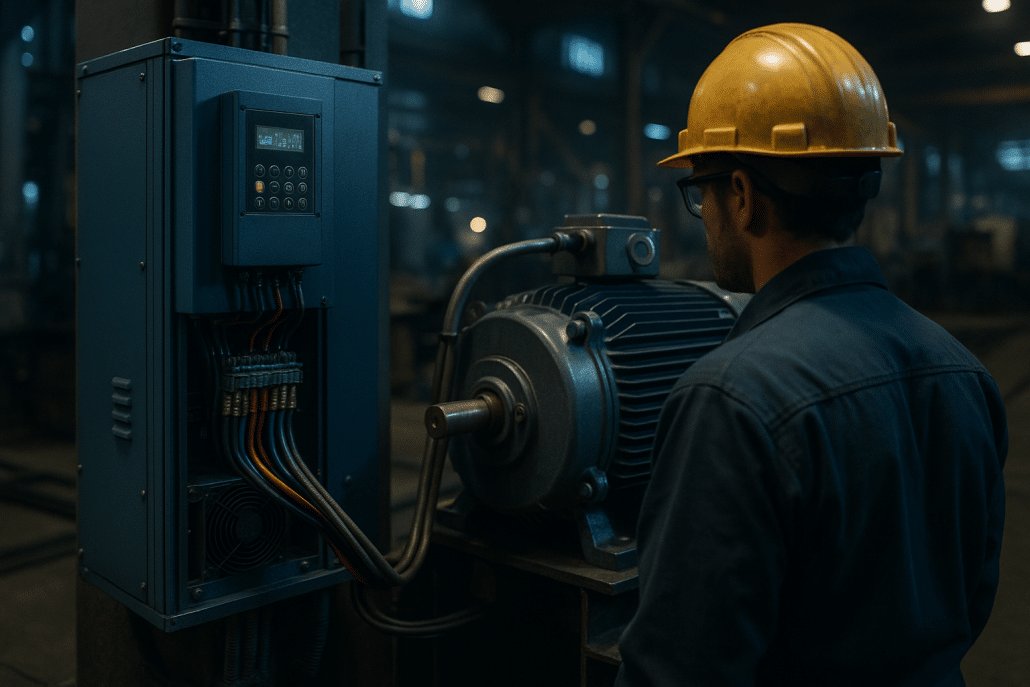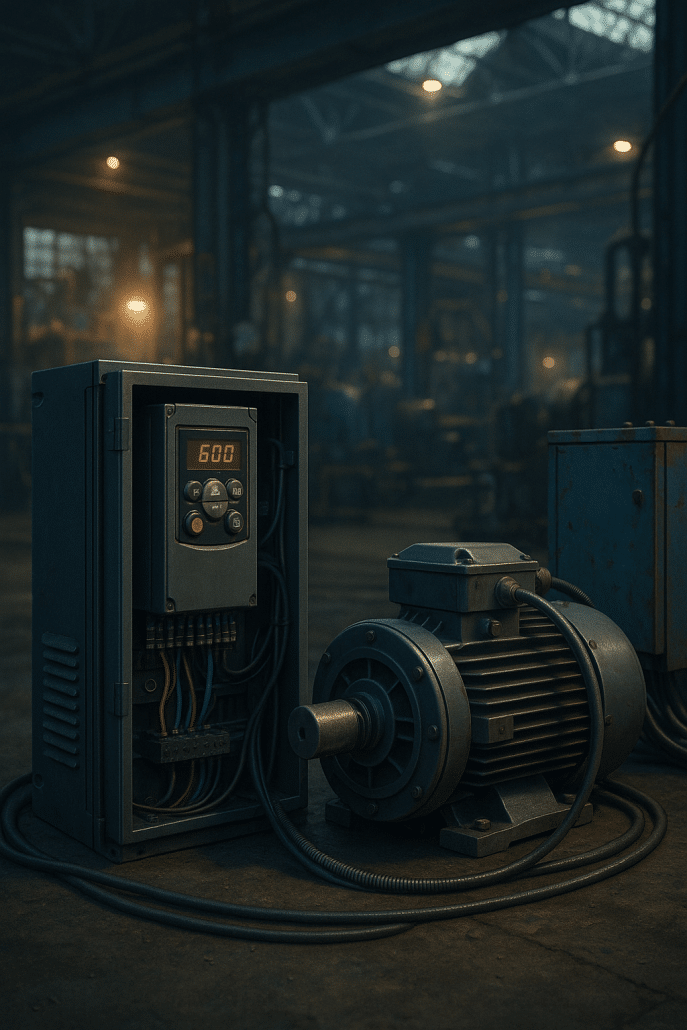VFD And Motor: Proven Methods To Maximize Efficiency
Estimated reading time: 6 minutes
Summary: Pairing a vfd and motor unlocks precise speed control, smoother starts, and measurable energy savings. This guide distills manufacturer-backed practices and field-proven tips so you can specify, install, and tune systems that run quieter, last longer, and cost less to operate.
Across plants, buildings, and infrastructure, motors rarely need to run at full speed. A variable frequency drive (VFD) lets you match speed and torque to the load in real time. Consequently, a well‑applied drive and motor package reduces inrush current, minimizes mechanical shock, and improves process control. Throughout this article, we connect concepts to real documentation and resources from ABB, Yaskawa, Hitachi, Lenze, and Eaton, and we link to Precision Electric’s cornerstone guides for deeper dives.
Before we get practical, bookmark these foundations: a concise overview of variable frequency drives, hands‑on VFD programming basics, and an application‑focused VFD for pumps explainer. We will refer to them as we map causes, solutions, and product options for any vfd and motor project.
How VFDs Work With Motors
At its core, a VFD rectifies incoming AC to DC and then inverts it back to AC using high‑speed transistors. The inverter synthesizes a variable‑frequency, variable‑voltage output so the drive and motor run exactly as fast as the process demands. Because induction motor speed is set by frequency, reducing frequency reduces RPM; pairing the proper voltage with that frequency maintains flux and torque. Moreover, ramping from zero to setpoint avoids the 6–7× inrush current typical of across‑the‑line starts, which reduces heat, nuisance trips, and belt or coupling shock.
For most pumps and fans, scalar V/Hz control is simple and effective. However, sensorless vector or closed‑loop vector control improves low‑speed torque and response for conveyors, hoists, and mixers. ABB’s introduction to variable speed drives explains these modes clearly and shows why matching voltage to frequency preserves torque (ABB: What Is a Variable Speed Drive?). Likewise, Yaskawa’s GA800 product brief highlights practical features—autotune, torque limits, and skip‑frequency bands—that make a vfd motor system more stable during commissioning (Yaskawa GA800 Industrial AC Drive).
In real applications, waveform quality matters. Long motor leads and fast switching can raise motor‑terminal dv/dt and reflected‑wave peaks. Therefore, users often install output reactors, dV/dt filters, or sine‑wave filters to protect insulation and reduce acoustic noise. Additionally, line reactors or DC chokes on the input side limit harmonics, improve drive immunity to surges, and satisfy many site power‑quality policies.
Causes And Solutions In Applications
Heat and Overload: If a motor runs slowly for long periods, its shaft‑mounted fan moves less air. Consequently, a standard TEFC motor may overheat at low speed under high torque. To mitigate, specify an inverter‑duty motor or add external cooling, and set realistic acceleration times. If the load is heavy at crawl speeds, closed‑loop vector control can supply near‑zero‑speed torque while current‑limit parameters protect the vfd with motor package.
Insulation Stress: PWM edges can create high dv/dt and terminal overvoltage, especially with cable lengths over ~100 ft. Accordingly, choose inverter‑duty motors meeting NEMA MG 1 Part 31 guidance and add a dV/dt or sine‑wave filter for longer runs. Hitachi’s inverter application materials emphasize input impedance and output filtering for stable systems (Hitachi Industrial Inverters).
Bearing Currents: High‑frequency common‑mode voltage can induce shaft currents that pit bearings. Therefore, install a shaft‑grounding ring and, where appropriate, an insulated bearing on the opposite end. Pumps & Systems explains why “inverter‑duty” ratings and grounding practices are essential for an ac drive and motor retrofit (What Is an Inverter‑Duty Rated Motor?).
System Harmonics and Trips: On the line side, a 3%–5% line reactor reduces harmonic current and protects the rectifier. On the load side, a reactor or filter reduces motor‑terminal peaks and audible whine. Additionally, set skip‑frequencies to avoid structural resonances and apply conservative decel ramps to prevent overvoltage faults. When in doubt, refer to our service team’s field notes on VFD overheating causes and fixes and common overcurrent faults.

Best Practices
Size For The Job: Start with accurate load data. Select a drive with continuous current ≥ the motor FLA, and consider a margin for ambient temperature and enclosure losses. Treat motor service factor as 1.0 under VFD operation because harmonics and cooling limits erase the “extra” capacity. Additionally, keep cable runs short; if the layout forces long leads, plan for output filtering.
Program Methodically: Enter motor nameplate values, perform an autotune, and verify rotation before coupling the load. Then, set accel/decel, torque limits, and minimum speed. For pumps or fans, select “variable‑torque” mode to save energy at partial loads. For hoists or indexing conveyors, prefer sensorless or closed‑loop vector control. Yaskawa’s GA800 overview summarizes these choices in plain language (GA800 Features), and our technicians outline step‑by‑step checks in the VFD programming guide.
Filter And Ground Correctly: Input line reactors protect the rectifier; output load reactors or dV/dt filters protect the motor. Ensure shielded motor cable is bonded at least at the drive end and that the drive and motor share a low‑impedance earth. Moreover, keep control wiring away from power cables, and use built‑in EMC filters where compliance is required. Lenze’s i500 documentation illustrates compact filtering options for pump and fan duty (Lenze i500 Inverter).
Plan For Service: Stock a spare key‑pad, keep parameter backups, and label terminal designations. If a failure occurs, our team can evaluate your electric motor repair options or recommend a like‑for‑like drive replacement, including legacy migrations that preserve I/O and cabinet cutouts.
Product Recommendations For Projects
Because each application is different, choose hardware that supports your environment, load profile, and control strategy. For a clean retrofit path and broad horsepower coverage, start with our AC variable‑frequency drives category. Additionally, when line quality is marginal or many drives share the same feeder, specify input line reactors to reduce harmonics and transients. If long motor leads or older windings are unavoidable, output load reactors help limit dv/dt at the terminals. Where a conventional soft start suffices, you can simplify with soft starters. Finally, unique single‑phase supply situations may benefit from VFD phase converters that power three‑phase motors from single‑phase mains.
For municipal water and large‑HP pumping, medium‑voltage VFDs deliver soft starts, redundancy, and measurable energy savings; Eaton’s field results from a North Carolina water utility show how a properly engineered drive reduced plant energy and improved operational flexibility (Eaton VFD Solutions). Likewise, ABB’s application notes outline the 20–60% energy reductions typical in centrifugal loads when speed is matched to demand (ABB VSD Overview).

Conclusion: Align Your Strategy
A modern vfd and motor pairing gives you what fixed‑speed starters cannot: right‑sized energy use, tighter process control, and gentler mechanics. Use vector control when you need low‑speed torque, program realistic ramps, and add reactors or filters where the installation demands. Moreover, confirm motor suitability, protect bearings, and document parameters for fast recovery. As the examples from ABB, Yaskawa, Lenze, Hitachi, and Eaton show, applying these fundamentals turns a variable frequency drive and motor into a durable, efficient asset.
If you prefer help with selection, programming, or repair, contact Precision Electric. We configure systems, replace obsolete models, and tune controls so your vfd and motor investment delivers measurable, traceable results over the long term.









Trackbacks & Pingbacks
[…] these best practices, as outlined in technical papers from experts like Rae, ensures the entire VFD and motor system remains protected and […]
Comments are closed.